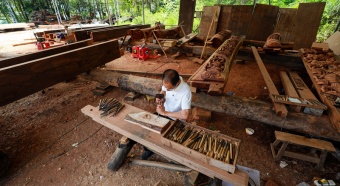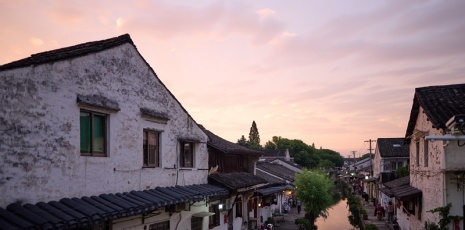A drop of water refracts the radiance of the sun, just as a house reflects the spring breeze of reform.
When I was young, I lived with my parents in the thatched cottage distributed during land reform in my hometown. Leaks were common in that cottage on rainy days due to long-term disrepair, leaving us busy using washbasins and foot buckets to pick up the rain water. Hitting my little heart, the sound aroused my desire to live in a decent house when I grow up.
I lived in a single dormitory of 8 square meters in the unit after work, and then moved to a 10-square-meter wedding house when I got married. Later, my child came, we three generations squeezed in this cloth-separated little house with small private space. In the summer night, every one of us had to take a shower, with one showering and the rest waited outside. Inconvenience was still not a big deal. I worked in township offices and had to exchange in a different place every one or two years, moving house with the old and the child for at least 10 times during the 20-year work period. Year after year, I’ve long been yearned for a bigger private house!
At that time, my family’s living conditions were similar to the national average level. In the early days of reform and opening up, welfare housing distribution was China’s dominant housing system, thus the vast majority of urban residents’ houses were rented from units or house management departments, and only few residents possessed their own houses. With a family of three or four people, even three generations, ate and lived together, big family and small residential area were then the most common living conditions of ordinary residents. In 1978, the per capita living area of urban residents in China was only 3.6 square meters, and the number of households lacking houses was 8.69 million, accounting for nearly half of the total number of urban households. Compared with the national per capita living area of urban residents in China, ours was quite large.
After 10 years of piloting reform, the landmark house system document named “Notice of the State Council on Further Deepening the Reform of Urban Housing System and Accelerating Housing Construction” was promulgated in July 1998. The document announced that the towns and cities nationwide shall stop physical housing distribution in the second half of 1998, gradually implement monetization of housing distribution, and establish and improve the affordable-housing-oriented housing supply system.
In November of that year, working in a town near the county, I harvested the first fruits of housing reform, and had a slightly larger housing space, with one room for a family of three, and the other for my parents. Though convenience was much more on our sides, creature comforts were unsatisfying: an indoor toilet was our urgent need.
Fortunately, in view of housing reform policies, I have been 50 years old and had the right to build house on my own. Upon making the ultimate decision, we built a small building of 5 rooms and 2 bathrooms (and a 10-square-meter writing room for myself) with all our savings and the borrowed fund. On the day of entering the house, I had a drink for the first time, feeling really happy by the spring breeze of reform.
Afterwards, my child settled in the provincial capital. In May 2006, we sold the small county building with reluctancy, paid down payment for the child’s three-bedroom urban house, and moved to the provincial capital.
After another 10 years, the child bought a spacious house in the provincial capital by himself for us to live. Knowing that I like playing table tennis, he specially prepared a tennis room for me, along with a writing room and a small garden outside the house, constituting a comfortable living space.
Since 2003, the state has successively issued a series of documents such as “Eight National Articles” and “Six National Articles”, proceeding housing system reform and tightening control of the real estate market. Since the 18th National Congress, the per capita housing construction area of urban residents has increased from 32.9 square meters in 2012 to 36.6 square meters in 2016, with more than 60 million slum dwellers going out of their houses and moving into buildings.
For Chinese, housing is of top priority. From cottages in the 1960s, tube-shaped apartments in the 1970s, apartment buildings in the 1980s, and “two-room” or “three-room” flats in the 1990s, to small high-rises and duplex apartments in the new century, we see people’s changes in perception from “longing for a house”, “possessing a house” to “improving living conditions”, profoundly reflecting progress of the times and reform. While pursuing housing spaciousness, people are also seeking comfortable living from various supporting facilities in the living environment.
Objectively speaking, the housing price in many places has soared in recent years, yet the achievements of China’s housing construction in the past 40 years are indisputable. According to the reform idea that housing is used for living, further improvement of housing conditions for urban and rural residents is an inevitable trend.









